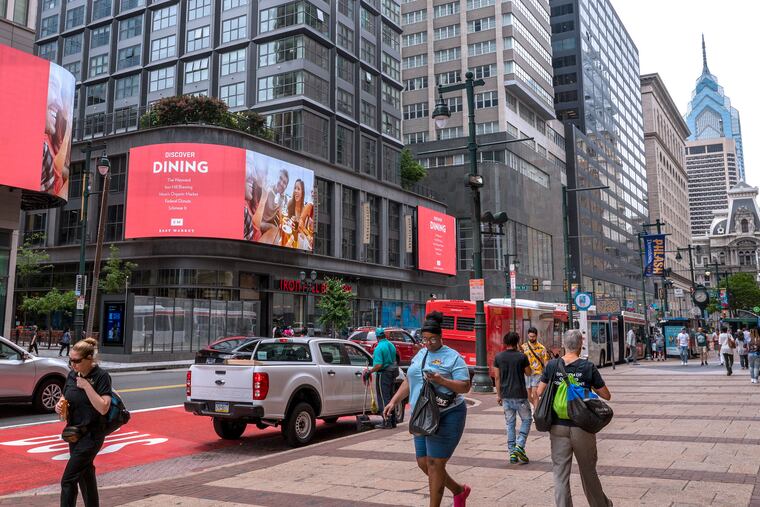Whither Market East? | An Arena for All
If done right, the arena could transform Market Street into a dynamic and vibrant hub for all Philadelphians.

Is Philadelphia ready to rethink the proposed Sixers arena as more than a stand-alone sports venue? The development team and city officials continue to assert that 76 Place has the potential to serve as a catalyst — the one project that will finally unlock Market Street’s potential as a successful mixed-use corridor. Can the arena, in its current iteration, realize this promise?
This series has examined the urban design principles that could make the arena a success: considering the central role of transit, seizing the opportunity to create vibrant public spaces, using bold architecture to create an iconic landmark, and striving to be a good neighbor by not turning its back on the city around it. This principle expands the civic lens to explore how, if done right, the arena could transform Market Street into a dynamic and vibrant hub for all Philadelphians.
Market East is one of Philadelphia’s greatest untapped assets. The Center City District has outlined a clear equation for its revival: enhance existing infrastructure, preserve historic buildings, create connections, and accelerate retail, residential, and hospitality development. The arrival of 76 Place could represent a key piece of this puzzle, but only if the project aligns with these goals.
The current design, however, falls short. Its inward-facing structure prioritizes eventgoers over the city’s daily life. It could ultimately leave a serious gap on Market Street, creating long periods of inactivity. This approach threatens to leave Market Street disconnected and underutilized, mirroring the failures of previous developments like the Gallery and DisneyQuest, which promised renewal but ultimately withered.
This shouldn’t be surprising. Cities across the country have long struggled to leverage downtown arenas as catalysts for broader revitalization. An overreliance on event-driven economics leads to limited spillover effects. With a lack of coordinated mixed-use development, inadequate attention to transit, limited street-level activity, and ineffective public spaces, projects like Newark’s Prudential Center, for example, have largely failed at integrating with the existing urban fabric and activating their immediate surroundings.
Some cities have recognized that an arena, in and of itself, is not an effective revitalization strategy. Edmonton, Alberta’s Ice District, for example, anchors the Rogers Place arena, with a mixed-use district, with a pedestrian-focused design that includes office towers, residential buildings, retail spaces, and public plazas, all designed to foster continuous activity and draw people downtown.
The District Detroit, anchored by the Little Caesars Arena, takes a similar approach. This project is still under development but highlights that a thriving surrounding community cannot be an afterthought. The project prioritizes integrating the arena into a larger mixed-use, walkable neighborhood as part of a broader plan to bridge downtown and midtown Detroit. The plan includes market-rate and affordable housing, parks and plazas, street-level dining, and retail, along with offices and commercial spaces.
How can we follow the lead of these more intentional and holistic approaches? We can start by addressing some key concerns:
Can nearby sites along Market Street be developed to create a 24-hour community that supports street life and ensures the arena isn’t just an isolated, intermittent node of activity? Yes, but only through a robust public planning process that establishes a vision for East Market Street from City Hall to the Delaware River. A vision that includes surrounding neighborhoods such as Chinatown, Washington Square West, and the Gayborhood, and includes a clear commitment to mixed-use pedestrian-focused development.
Could sites near Chinatown be designated for community-driven development? Current plans fail to acknowledge Chinatown’s role as a vibrant and cohesive community. Making space for Chinatown, not ignoring it, is the key to celebrating its cultural identity. Affordable housing, community-serving retail, and cultural programming could complement the arena while supporting the neighborhood.
Can the Fashion District complement arena activity as a true destination? Doing so would be a huge win. Restaurants, entertainment venues, and open plazas could serve as extensions of the arena’s energy, attracting visitors and creating new opportunities for local businesses.
With the proposed Sixers arena, we have an opportunity to tap into amazing potential, but only if it is to be a great civic building that meets high standards for connectivity and access, serves as a good neighbor, contributes to the life of the street, and sparks the revitalization of Market Street from the Delaware River to City Hall.
If anything, we hope the questions we’ve raised throughout this series help to inform and kick-start a rich civic conversation. Together, we can make the arena a great civic asset every day — not just on game days. A building with a sense of place authentic to Philadelphia that leads to an improved East Market Street. One that we can look back on as providing the tipping point for a revitalized Market East worthy of being Philadelphia’s Main Street.
Harris M. Steinberg, a fellow of the American Institute of Architects, is the executive director of the Lindy Institute for Urban Innovation at Drexel University. To learn more about our urban principles and a detailed analysis, visit the Lindy Institute’s Civic Design Studio website.